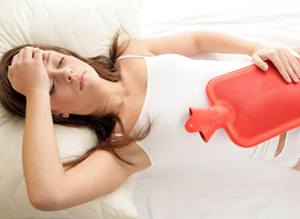Tips for Treating PMS
Do you suffer from mood swings and feelings of fatigue and depression from one to two weeks before your menstrual period? Are you bothered by headaches, backaches, irritability or forgetfulness? Do you feel boated, gain weight and crave sweet and salty foods?.

Chart your symptoms on a calendar. Make note of when symptoms begin and when they cease. Rate the severity of symptoms on a scale of 0 to 10, ranging from 0 (absent) to 10 (most severe). After three months, take your chart to your physician as documentation for the treatment of PMS symptoms.
If you suffer from monthly PMS symptoms and want to try to restore yourself to good health and adopt a healthier lifestyle, you may find these 17 tips to be just what you need to help relieve your PMS symptoms.
Tips that may help
- To help stabilize blood sugar levels, counteract mood swings and fatigue, and to help control chocolate cravings it is helpful to eat 4-6 small meals a day whenever you feel symptomatic. Eat in moderation. There is no reason why you need to give up any food you especially adore. Eating your craved food every day may not be healthy (too much fat, sugar or too many calories). But there is nothing wrong with eating most craved foods once a week or once a month. Moderation also means portion control. High sugar foods may cause swings from irritability and hyperactivity to a crash of lethargy and fatigue and a craving for more sweets. Avoid anything that tastes sweet.
- Variety in your diet is essential to obtain the proper balance of needed nutrients and to avoid possible excesses. In general, a low-fat, high-fiber, nutrient-dense diet should be consumed, adequate in all vitamins and minerals and low in sugars and refined and convenience foods.
- Increase intake of complex carbohydrates. Eat whole grain cereals, breads, brown rice, legumes, fresh fruits and vegetables—foods that are slowly broken down and efficiently utilized by the body.
- To help rid your body of fluid buildup, eat vegetables which are a natural source of potassium.
- Food rich in vitamin B6 and magnesium are thought to play key roles in the production of serotonin, a brain chemical linked to mood. The best sources of B6 are brown rice, whole grains, nuts, beef, pork and bananas. For magnesium, eat more seafood, nuts, beans and spinach.
- Studies have shown that approximately ten days before menstruation, the blood calcium and zinc drops steadily and progressively. The results can be premenstrual tension, nervousness, headaches, insomnia and depression. The decreased calcium and zinc acts as a stress on the body, causing weight gain and lowering resistance to allergies and infections. Zinc is found in the following food sources: fish, legumes, meats, oysters, poultry seafood and whole grains.
- Eat plenty of fresh fruits. They have bioflavonoids that help balance the urge to eat salty foods. Vitamin C and potassium provide the body help to utilize the extra B vitamins.

- Vitamin E helps improve a wide range of emotional and physical symptoms. Some natural food sources are vegetable oils, green leafy vegetables, whole grain cereals, wheat germ and egg yolk.
- Alcohol is known to cause irritability, mood swings, lethargy and fatigue. Cut down or eliminate alcohol from your diet.
- Avoid salt. Table salt, seasoned salts and MSG are taboo. Limit your intake of chips, salted snacks, pickles and olives. Sodium causes fluid retention and swelling in the joints, breasts and abdomen. Use herbs and moderate amounts of spices to flavor your foods.
- Cut caffeine from your diet. Caffeine found in coffee, tea, colas and chocolate may make you jittery and irritable and interfere with restful sleep. Check the labels on over-the-counter pain relievers for caffeine content. Enzyme levels in breast tissue are sensitive to caffeine.
- Reduce consumption of fats, particularly saturated ones. Rich foods may cause nausea, increased cramping and other symptoms.
- Drink at least one quart of water daily, especially one week before the menstrual period and ending one week after.
- Exercise. An exercise program helps move out fluid, alleviating brain swelling and sluggishness. It also elevates mood, helps you sleep better and raises the levels of endorphins, your body’s natural painkillers. Create an exercise plan to include 30 minutes every day or an hour every other day. Make it fun. If you hate what you are doing, you won’t be faithful.
- Reduce stress. Listen to soothing music while traveling to and from work or as you work around home. Find ways to relax. When the body is under stress, the hormonal changes cause water retention, high blood glucose and hormonal imbalances.
- Get enough sleep. Adequate sleep helps curb feelings of irritability and fatigue.
- Take control of your life. Resolve to do things that are good for you. Adopt a healthier lifestyle.
Doses of some nutrients that may help:
- Magnesium – 300-700 mg/d in divided doses
- Calcium Citrate – 1200mg/d in divided doses
- B6 – 50-100mg/d
- Vitamin E – 400 IU/d


 Online Scheduling Request
Online Scheduling Request 